|
By Germanboy - 9 Years Ago
|
Since more than 6 years I have an ugly oil water emulsion in my oil cap. The oil in crankcase is clean (no water emulsion). After cleaning the cap will have water oil emulsion after 50 mls.
Motor runs perfect.
Any ideas about?
Thx
Andreas
|
|
By Y me - 9 Years Ago
|
|
My 292 will have that too , in fill tube and dipstick tube not in oil. It seems like the cause is short run times not allowing condensation to be cooked off. Long highway cruze took care of it for me.
|
|
By Y me - 9 Years Ago
|
|
I'll add. My 292 has been converted to closed pcv system if that matters.
|
|
By Cliff - 9 Years Ago
|
|
Time to do a pressure test on the cooling system, it will only get worse in time.
|
|
By miker - 9 Years Ago
|
|
Under idle or cruise conditions the outside air is entering thru the oil fill cap, and leaving the crankcase thru the PCV valve and into the intake. The mesh in the cap is oil covered and works as a filter for the incoming air. That cap doesn't get very hot in cold damp weather, and you don't say where you are. If you're somewhere cold and damp like Seattle right now, and you're doing short trips at low speeds, I'd say it's normal. If you're in the sw desert at 70 degrees, different case. I'd think if it's been going on for 6 years you'd know by now if it was a cooling problem.
|
|
By Talkwrench - 9 Years Ago
|
After 50 miles I would think its hot enough to stop condensation BUT are you in winter? AS suggested a pressure test could confirm anything else.
attached is the cap off my 35 Pickup [flathead] I just cant get it hot enough in winter and driving to work is not doing it much good as I have noticed sludge building up in the pan too.
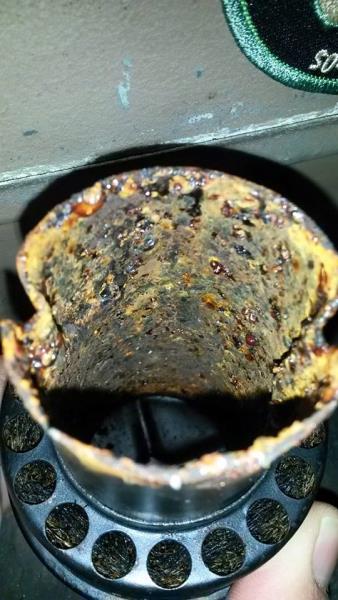
|
|
By PF Arcand - 9 Years Ago
|
No details on the engine given, but is your crankcase ventilation clear & working? If there is no thru venting both upper & lower, that may be the cause.. The oil fill cap screen can get clogged with dirt easily & if your engine has the lower canister filter setup, the filter needs to be serviced once in a while..??
|
|
By Germanboy - 9 Years Ago
|
Hi Paul,
good question. The vent seems to be ok. All tubes and hoses are free. For details see pics.
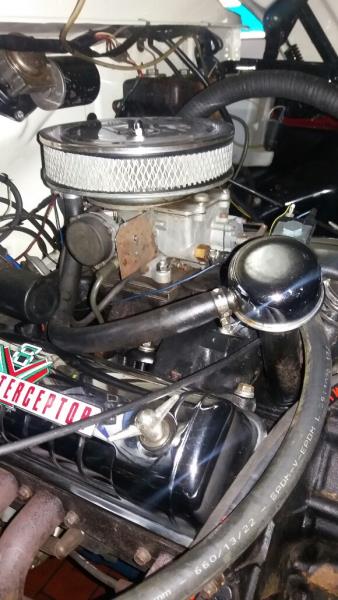
Oil fill cap to aircleaner
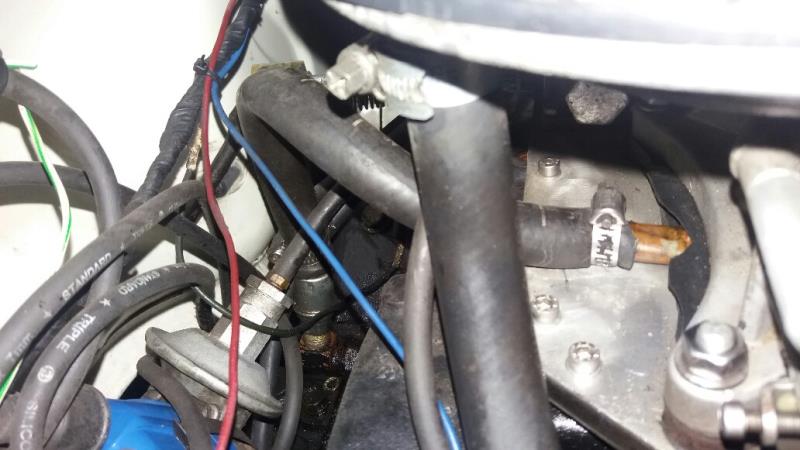
Pcf to intake /carb
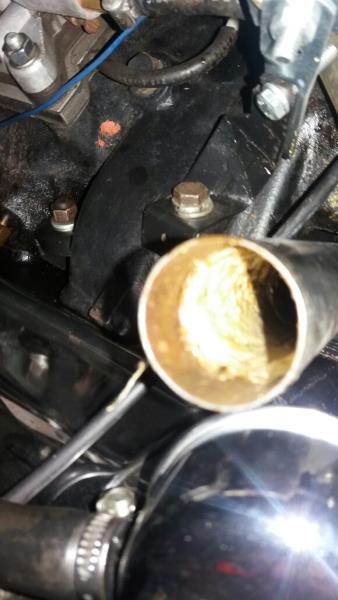
View into oil fill tube
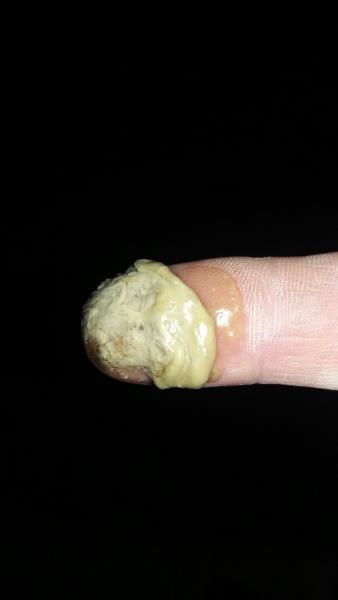
My dirty oil finger
|
|
By Germanboy - 9 Years Ago
|
Cliff (12/11/2016)
Time to do a pressure test on the cooling system, it will only get worse in time.
Yes, will ask my favorite workshop, hopefully they don't want to convince me to order a new 292 ... ;-)
|
|
By 2721955meteor - 9 Years Ago
|
|
my guess is you do not have circulation. the hose from the breather is competing with the pc valve..if the breather on the bottom of the block has bin blocked you will have oil accumulating in the v as well. the competition especially when rpm increases.. just my take.
|
|
By Germanboy - 9 Years Ago
|
... Breather on the bottom of the block? Pls explain where it is placed.
Thx
Andreas
|
|
By 2721955meteor - 9 Years Ago
|
Germanboy (12/12/2016)
... Breather on the bottom of the block? Pls explain where it is placed. The drivers side lower front. tho if your truck has original block it may be cast shut,or earlier blocks have a cover. or the breather will be bolted on the aria described Andreas
|
|
By Talkwrench - 9 Years Ago
|
|
My take on this is remove the line from the breather to the air filter, its possible you are sucking oil up from the valley. You have a PCV by the looks of it so the draft tube on the block will be blocked off.
|
|
By miker - 9 Years Ago
|
Ok, that looks like a proper "closed" PCV system to me. Closed oil fill cap, rubber hose to air cleaner inside the element. PCV valve in valley pan and hose to fitting under carb.
What meteor is asking is if you blocked off the road draft tube when the PCV system went on. Some draft tubes were off the back of the valley pan, but most car applications were down by the fuel pump. I don't think late motors were even machined for them. But the canister needs to be removed and a block off plate fabricated. Otherwise, the closed system has a big leak and doesn't provide the circulation thru the motor it was designed for.
This is what talkwrench posted while I was posting this. That fill cap and hose to the air cleaner should work fine, it's the same set up I used on both my yblocks.
|
|
By Cliff - 9 Years Ago
|
That oil has water in it, it has an internal leak, it may stay the same or get worse, it may just take a re torque of the heads however something must be done.
Cliff
|
|
By miker - 9 Years Ago
|
Cliff, you're right, the oil has water in it. But having spend my life in the Pacific Northwest I can tell you that water gets in thru the atmosphere and won't clear unless the engine stays at temperature and the road draft of PCV system works well enough to clear it.
In the winter of 1969, over Christmas, it was just over 32 degrees and constant light rain. Driving short trips to see my friends instead of the 20 mile trip to school, I pulled the valve covers to set the valves and found 1/2 inch of foam. Freaked out. Dad came home and said " yeah, they do that all the time. Go get it warm". I went 25 miles up the freeway and 25 miles back. Pulled the valve covers and they were clean.
1: the old man was right, as usual.
2. It's the reason I'm a big believer in closed PCV system, and not doing just short trips.
|
|
By 57RancheroJim - 9 Years Ago
|
I use to have a similar problem on my 223 I6, switching from the factory 160 thermostat to a 180 helped a lot. I also use a 180 in my Y block.
|
|
By The Master Cylinder - 9 Years Ago
|
Water is also a byproduct of combustion and a certain amount bypasses the rings. I agree that you should ensure you are getting the engine warm enough to vaporize the water (and other nasty stuff) in the crankcase. Use a 180 or 190°F thermostat and don't run the engine for short amounts of time. Not getting an engine up to temperature is also hard on your exhaust system.
Also, as stated, ensure your PCV system is working as it should.
|
|
By 2721955meteor - 9 Years Ago
|
|
the picture of the system points to the cap on the oil filler is most likely a issue,the hose to the air cleaner is to try and eliminate excessive blow by or error,as the cap on oil filler must be free to alow air into the engine and this will alow the pct to function correctly. I to live in a wet damp aria surrey bc and have no such issues. do a lot of short runs,. i left the old road draft on the block as well as a pcv system and a proper cover on oil filler. 180 stat. never smell fumes ,no condensation in filler. engine is not fresh but burnes no oil. this site has a lot of solutions,most won't work,some will.
|
|
By Joe-JDC - 9 Years Ago
|
|
As an automotive instructor for a couple of years at the Junior College level, it was taught that an engine needs to get up to operating temperature for a certain number of minutes or driven at least a minimum of miles so that the water vapors inside the engine would be eliminated. We always taught that an engine needs at least 20 minutes of continuous running, or seven miles driven at normal city street speeds or above. Backing a vehicle out of the garage to get access to another vehicle, or wash it, and pull it back in is one of the worst things you can do for the oil and combustion chambers. Proper thermostat temperature range, letting the oil and water temperatures get up to operating specifications, and driving the vehicle are the best remedies for oil dilution or milky build up in the valve covers. The milky oil sludge will build up even in warm climates if you do not drive the vehicle to get it up to operating temperatures for several minutes. Joe-JDC
|
|
By Talkwrench - 9 Years Ago
|
Joe-JDC (12/14/2016)
As an automotive instructor for a couple of years at the Junior College level, it was taught that an engine needs to get up to operating temperature for a certain number of minutes or driven at least a minimum of miles so that the water vapors inside the engine would be eliminated. We always taught that an engine needs at least 20 minutes of continuous running, or seven miles driven at normal city street speeds or above. Backing a vehicle out of the garage to get access to another vehicle, or wash it, and pull it back in is one of the worst things you can do for the oil and combustion chambers. Proper thermostat temperature range, letting the oil and water temperatures get up to operating specifications, and driving the vehicle are the best remedies for oil dilution or milky build up in the valve covers. The milky oil sludge will build up even in warm climates if you do not drive the vehicle to get it up to operating temperatures for several minutes. Joe-JDC
That is my understanding as well... I am right on 20 minutes to get to work and my ol' flathead is still not up to temp even with the radiator covered and 180 thermostats [almost unheard of in a flathead!] this with winter weather, which is not that cold here, but still gives me condensation as you see from my earlier picture, guess its just the cold air getting sucked in too as it rests.
Someone once said it also takes about 20 minutes to put the charge back in your battery from starting it too..
|
|
By 2721955meteor - 9 Years Ago
|
|
rodgers pictures ar great,they show that the original post is incorrect and ther is no proper circulation. the pcv sucks from the same source the valley cover and valley cover air in promotes limited circulation,even if the system where closed
|
|
By Kahuna - 9 Years Ago
|
Meteor, I have the same setup on my car as yours. Did you block off the vent holes in the oil fill cap?
My car is not running yet, just wondered?
Thanks
Jim
|
|
By 2721955meteor - 9 Years Ago
|
Kahuna (12/15/2016)
Meteor, I have the same setup on my car as yours. Did you block off the vent holes in the oil fill cap? My car is not running yet, just wondered? Thanks Jim
no i did not block off the filler cap,my road draft(original type)worked fine but got the odd smell of base bloby so made a pct set up.
|